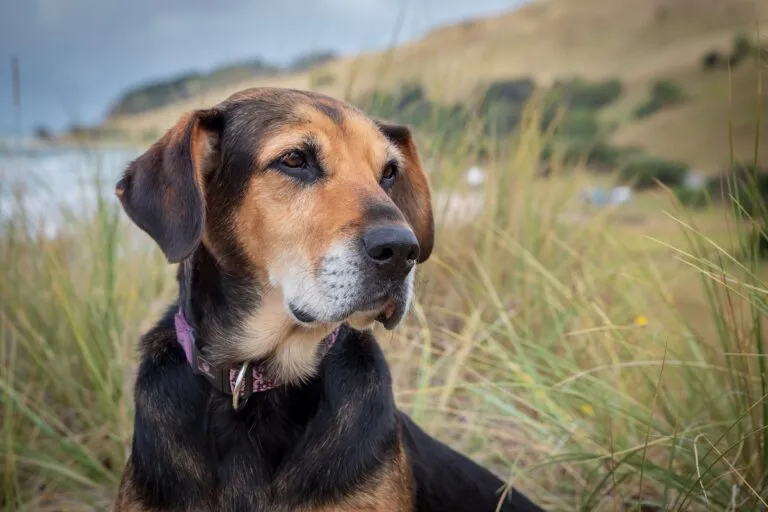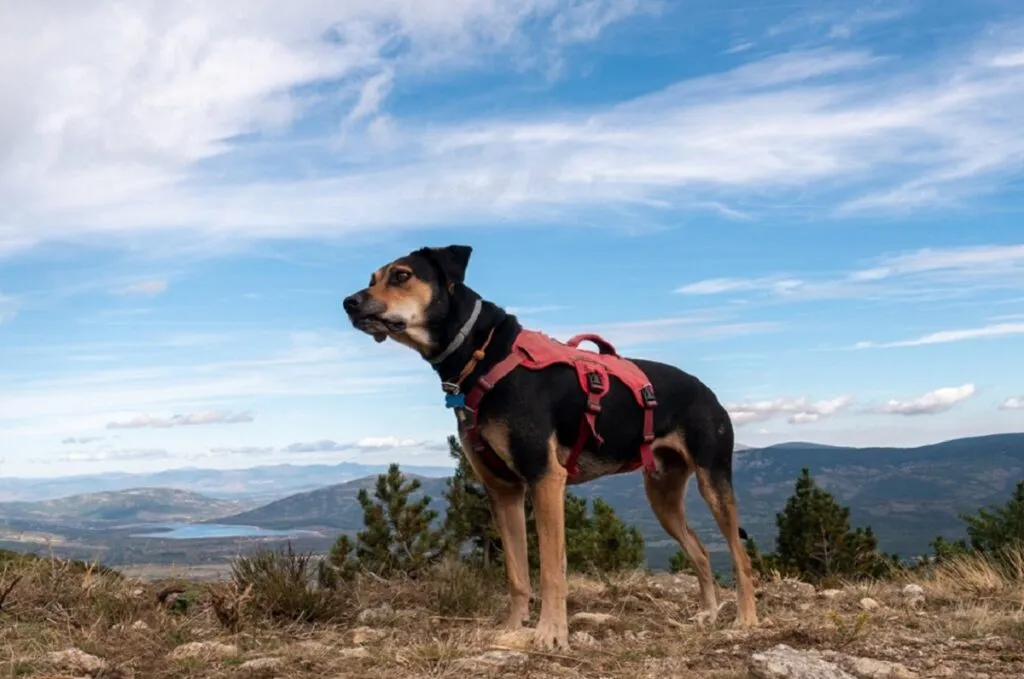Medium Size Poodle
When the New Zealand Huntaway is working, you can hear it for miles: The farmer's dog drives livestock with loud barking in the right direction. Find out more about what makes these special dogs unique in our breed profile.

The New Zealand Huntaway was bred to herd livestock with loud barks.
Breeders of this dog type focus exclusively on the dog’s ability to perform well around the herd. The most talented herding dogs are the ones that produce offspring.
Their appearance is of secondary importance, hence there is no breed standard.
The New Zealand Huntaway typically stands about 56 to 66 centimetres tall and weighs between 25 to 45 kilograms.
As a hardy herding dog, it has a broad chest and an athletic build. The ears are usually drooping, but folded ears are also possible.
There are both long-haired and short-haired Huntaways, with the latter being more common.
The predominant colours are black combined with various shades of tan and white.
The New Zealand Huntaway is bred to herd livestock with loud barking. Accordingly, this dog is independent, very active, and enjoys barking.
They are friendly towards humans. Despite their inclination to bark, they are usually not good guard dogs. Most Huntaways are social and get along well with other dogs or pets.
Anyone who keeps this type of dog should enable it to work with a herd, as training will only be successful if the Huntaway is engaged in a species-appropriate job.
Loving but firm consistency is required. It’s important for this high-drive breed to consciously practice down-time in everyday life. This helps the dog learn to manage its high energy levels regularly because relaxation needs to be learned, too!
Yes, barking is its job. Unlike many other herding dogs like the Border Collie, the Huntaway herds the flock with barking. Making itself heard is part of its nature.
According to many New Zealand owners, the most important commands from puppyhood are accordingly “speak up” to command barking and “quiet” as a stop signal.
The New Zealand Huntaway loves to be active outdoors during the day. It’s not suited to being a city companion dog. A short morning walk in the park, four hours in the office, and a long walk at lunchtime will not suffice for a New Zealand Huntaway.
Therefore, the question of whether to live in an apartment or a house is clearly answered for the New Zealand Huntaway: This fur companion should reside in a rural area, ideally belonging to a farm.
They love being outdoors in all weathers and require lots of exercise.
Since the New Zealand Huntaway comes in many different coat types, the maintenance required can vary.
However, this animal typically has an undercoat and tends to shed especially heavily during the shedding season. Daily brushing during this time helps – yet the breed may not be suited for those who prefer a clinically clean living space.
Since these dogs have floppy ears, owners should regularly clean the ears to prevent ear infections.
A Huntaway with a job can be a great companion even for a novice farmer.
Of course, the owner should actively learn about the specifics of working herding dogs.
Providing the Huntaway has a fulfilling job, it can also enjoy family life: It gets on well with children. Other four-legged pack members such as dogs or similar breeds usually harmonise well with the New Zealander.
It’s known to be friendly to both the young and old. However, care must be taken that the Huntaway doesn’t start herding the human youngsters with barking.
Herding dogs like to be engaged with their flock the most. They need lots of mental and physical stimulation and are true working dogs. Since they work mainly through their piercing barking, they may find it hard to get excited about dog sports like Treibball.
The intelligent Huntaway can learn tricks or enjoy scent work like mantrailing. Many Huntaways learn to understand and follow distant signals quickly, according to their herding tasks.
This is not only useful when driving sheep but also beneficial for dummy training. Yet their greatest passion remains herding with a significant wow-effect!
Generally, the Huntaway is a very robust outdoor breed. However, as with many large dogs, hip dysplasia and heart diseases are potential health risks for the New Zealand Huntaway.
Moreover, some Huntaway lines have a genetic disease named Mucopolysaccharidosis (MPS) IIIA.
This is a lysosomal storage disorder. Dogs affected lack an enzyme, causing their nervous system to increasingly deteriorate over time. Neurological symptoms appear in affected dogs at around 1.5 years of age.
The disease is inherited autosomally recessive. Genetic testing can now exclude carriers from breeding.
These dogs are bred primarily for their unparalleled qualities as hardy work dogs. As such, with good health, they can live to be twelve to fourteen years old.
From puppyhood, a lot of emphasis should be placed on healthy skeletal development for this fur buddy. Given that the final size isn’t predictable, feeding tables and recommended food amounts for puppies of large breeds may be helpful.
The adult Huntaway is very active, so a high-quality dog food with a high meat content is recommended. There should always be plenty of fresh water available for the athlete.
The first dogs of the Huntaway type were bred around 1900, at which time there were significant sheep populations on the island of New Zealand.
Traditional herding dogs like the Border Collie could not cope with the size of the farms or the mild climate with high humidity.
Besides the Border Collie, likely ancestors of the Huntaway include the Labrador Retriever, Rottweiler, Bearded Collies, Harrier, Gordon Setter and Smithfield Collie.

In New Zealand, the Huntaway has been very popular for many decades – alongside the Labrador Retriever, it is the second-most common dog on the island. There are now clubs for them in other countries, such as Japan.
The Huntaway is also becoming popular on some farms in the UK. In the rest of Europe, however, the dog is extremely rare and is likely to remain so.
Those in search of a puppy should have some knowledge about working herding dogs themselves in order to locate the few reputable breeders.
Besides the mentioned potential ancestors of the Huntaway like the Border Collie and Bearded Collie among other herding dogs, there are numerous mix breeds that may resemble the Huntaway.
A European dog breed with great herding properties and a similar appearance is the Berger de Beauce, also known as the Beauceron. Generally, this French four-legged friend is somewhat calmer but less social compared to its fellow canines.
Anyone who manages a large livestock herd and wants to control it from a distance with a loud companion will find the friendly Huntaway the right choice.
They are scarce in Europe – however, there are numerous other herding dogs that could be an alternative.
| Features: | The New Zealand Huntaway is bred for herding sheep and suits those involved in agriculture. It’s not recognized by any kennel club as a breed. |
| Character: | enduring, work-loving, intelligent, friendly |
| Withers Height: | males: 61-66 cm, females: 56-61 cm |
| Weight: | males between 30-40 kg, females 25 to 35 kg |
| Coat: | all hair types allowed, the Huntaway with short black and tan fur is most common |
| Coat Care: | regular brushing required, especially during moulting – can shed heavily |
| Exercise needs: | high |
| Beginner Dog: | yes, if employed in agriculture |
| Barking: | likes to bark frequently, especially while herding |
| Lifespan: | 12 years |
| Typical Illnesses: | hip dysplasia, heart problems, and MPS IIIa storage disease |
| Price: | £1000 to £1500 |
| FCI Group: | none |
| Origin: | New Zealand |
Here are some purchase proposals curated by the zooplus editorial team
The products featured have been carefully selected by our editorial staff and are available at the zooplus online pet shop. The selection does not constitute advertising for the mentioned brands.
Fans of the Bearded Collie agree that those who aren't familiar with this dog breed simply have to get acquainted with it. And those who have experienced how a Bearded Collie bolts across meadows with its flowing fur, how it rolls around full of energy and joy and how it attentively and observantly takes into account its owners wishes become simply addicted to this original dog breed and its unique charm.
The Goldendoodle isn't a breed, but a pairing between Golden Retrievers and Medium or Standard Poodles. Marketed as a low-maintenance dog for allergy sufferers, this hybrid is enjoying increasing popularity amongst dog lovers, similar to the Labradoodle.